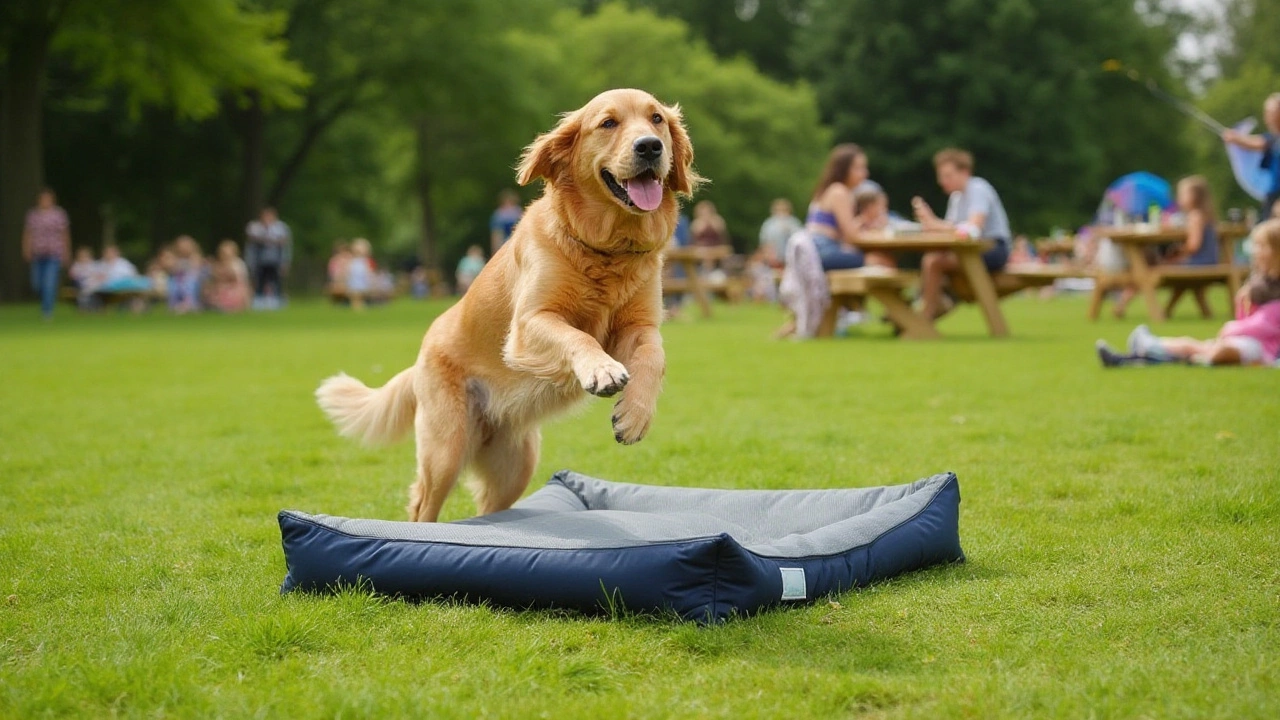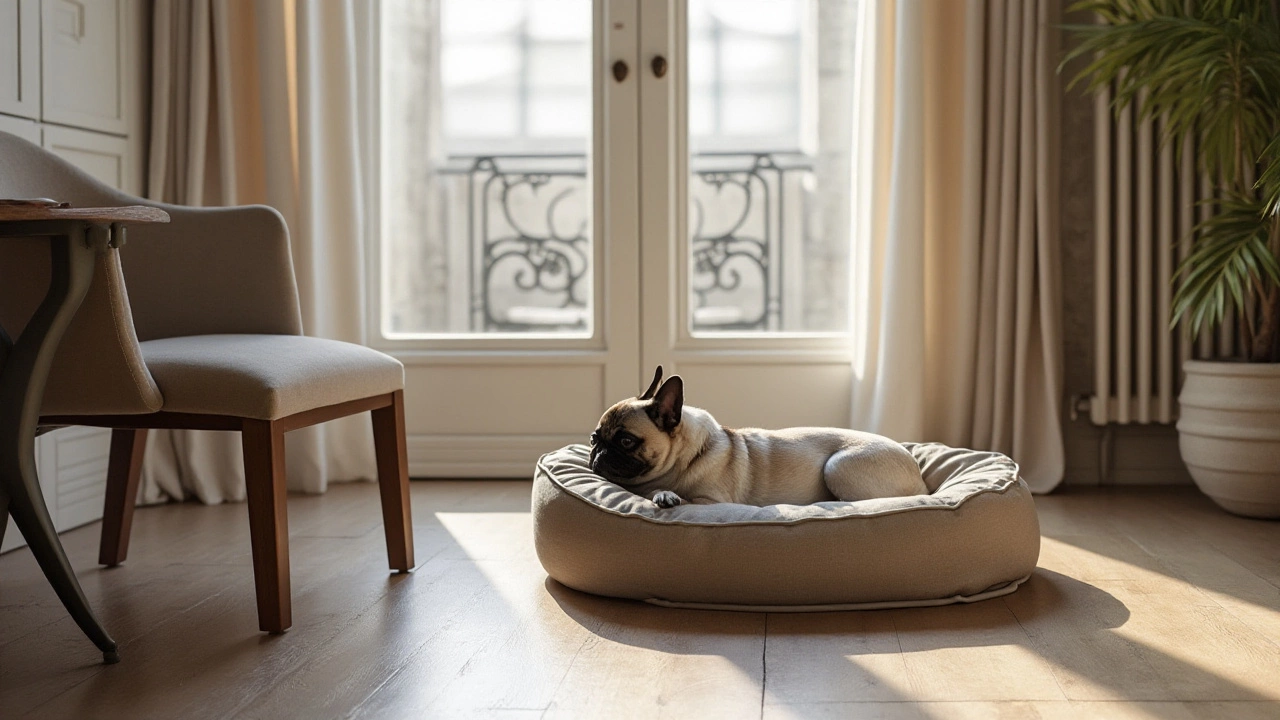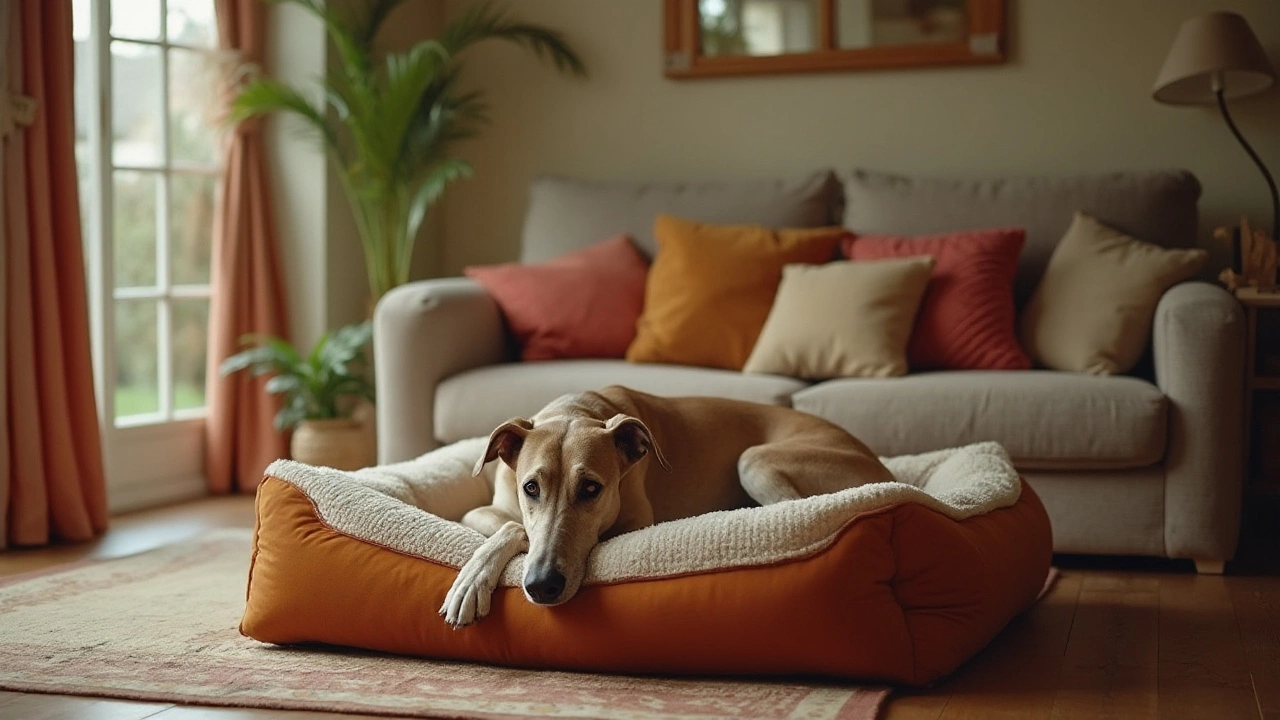Choosing a dog bed might seem like a straightforward task, yet it’s more nuanced than you might think. Your furry friend spends a lot of time snoozing, and the right bed can significantly enhance their quality of life. Dogs have various preferences when it comes to sleeping arrangements, and as their beloved humans, it's our job to make sure they're as happy as possible.
From the bed’s texture to its shape, every detail plays a role in the perfect resting spot for your pup. In this article, we'll delve into the types of beds dogs love most, what features to consider, and some tips to keep the bed in good shape. By understanding these aspects, you'll be well on your way to choosing the perfect place for your dog's dreamland adventures. Let's dive into the world of dog beds and find out what suits your canine companion best!
- Understanding Your Dog's Sleep Preferences
- Types of Dog Beds Available
- Factors to Consider When Choosing a Dog Bed
- The Importance of Size and Shape
- Material Matters: What to Look For
- Tips for Maintaining Your Dog's Bed
Understanding Your Dog's Sleep Preferences
Every dog, like every person, has its unique quirks and preferences, and this certainly extends to where and how they sleep. Understanding your pup’s sleep preferences can help you choose the most suitable place for their rest. Though dogs sleep around 12-14 hours a day, puppies and older dogs might need even more, making their choice of bed vital for their well-being. They might not verbally communicate their preferences, but their behavior offers some telling clues. Some dogs favor the security of a cozy, closed-off space, reminiscent of a den where they feel protected and nestled in warmth. Others might stretch out and enjoy the freedom of a spacious dog bed, allowing for an unrestricted sprawl, showing their confidence and comfort at home.
Temperature sensitivity is another factor affecting a dog’s sleep choice. Breeds with thick fur may overheat easier, prompting a preference for cooler, firmer surfaces. Alternatively, short-haired or smaller breeds often seek out warmth, hence choosing plusher, thicker beds or even opting to snuggle under a blanket. Height, surprisingly, might play a role too. Studies suggest that smaller dogs may prefer elevated positions where they can observe their surroundings, feeling like a guard keeping watch over their domain, whereas larger breeds might find it easier to sleep on more accessible ground-level pet sleeping arrangements.
"Just as humans have different sleep styles, dogs too have unique habits," says Dr. Karen Becker, an esteemed veterinarian. "Paying attention to your pet's behavior can lead you to the right solutions that enhance their comfort and health in multiple ways."
Some behavioral cues to mind include if your dog frequently changes positions or seeks new spots throughout the night; this might indicate discomfort or seeking a particular feel they are not getting from their current bed. It’s insightful to observe if your canine avoids their bed altogether. Sometimes, they just find it too hot or cold, or the texture might not be agreeable. By considering these factors and regularly observing dog behavior, you can discern whether your furry friend prefers a firm orthopaedic pad over a plush micro-fiber cushion. This knowledge arms you with the essential understanding needed to select the perfect canine rest solution to cater to their preferences.
Types of Dog Beds Available
When it comes to selecting the right dog beds for your furry friend, the abundance of choices might surprise you. Dogs, like humans, have their own unique set of preferences and needs, and matching those with the perfect bed can transform their sleep experience. From orthopedic beds for older dogs to luxury loungers, the possibilities are vast. One of the earliest considerations is the style of the bed. Traditional bolster beds, for instance, offer raised sides that add a sense of security and have long been the favorite of dogs who like to curl up while they sleep. These beds often provide ample support and serve as a cozy retreat.
Now, let's talk about memory foam beds, which are a godsend for aging dogs or those with joint problems. Memory foam contours to your dog's body, providing optimal support and alleviating pressure on achy joints.
"Memory foam beds are akin to mattresses for people – they offer incredible comfort and aid in maintaining healthy hips and bones," says Dr. Sarah Whitman, a renowned veterinarian with expertise in animal ergonomics.The cooling gel feature in some memory foam beds is an added bonus, especially for dogs living in warmer climates or those with thick fur coats. For those with smaller spaces, consider a corner bed, which can neatly tuck into unused areas.
If you have a playful or anxious canine, a chew-resistant bed might be best. These are crafted from durable materials designed to withstand enthusiastic dogs. Elevated beds are another interesting option, managing to stay cool by allowing air to flow beneath, making them perfect for outdoor lounging or in houses without air conditioning. Look for beds made from waterproof material if your dog loves to romp in the mud or is prone to accidents. With an ample variety of choices, there's always a perfect dog bed out there for your beloved pet.
Specialized Beds for Different Needs
Cave or hooded beds cater to breeds that enjoy burrowing. Think of small dogs who love to dig under blankets for warmth and comfort. Then there are heated beds, which serve as warm havens in colder months for dogs with arthritis or thin coats. Pet sleeping has never been more sophisticated, embracing technology with self-warming materials that radiate heat back toward the dog. Not to mention, travel beds made from light, compact materials allow for easy packing and provide your dog a touch of home comfort wherever the journey takes you.
| Dog Bed Type | Best For |
|---|---|
| Orthopedic | Older dogs, Joint pain |
| Bolster | Curlers, Comfort seekers |
| Elevated | Outdoor, Cooling needs |
| Cave/Hooded | Burrowers, Anxious dogs |
| Chew-resistant | Chewers, Energetic dogs |

Factors to Consider When Choosing a Dog Bed
When embarking on the quest to find the perfect bed for your four-legged friend, it's important to consider a multitude of factors that can greatly influence your dog's comfort and rest. The first consideration is undoubtedly the size of your dog. A bed that is too small will leave them feeling cramped, while a bed too large may not provide the coziness they crave. Measure your dog while they are stretched out to ensure you get a bed that suits their length and width, offering enough space to either curl up or sprawl out comfortably.
Next on the list is your dog's age and any health issues they may have. Older dogs or those with arthritis will benefit from orthopedic beds that offer more support. These beds typically come with memory foam that conforms to their body, alleviating pressure on sore joints. Younger, more active dogs might enjoy beds with raised edges or bolsters where they can rest their head after a day of playing and exploring. Consider also if your dog likes to chew; if so, look for beds with durable materials that withstand aggressive chewing.
The material of the dog bed can also play a crucial role in either attracting or discouraging your pet. Look for materials that are hypoallergenic, especially if your dog suffers from allergies. Also, consider the cleaning aspect—a bed with a removable cover that can be machine washed is highly practical. A renowned veterinary expert once said,
"A clean sleeping environment is just as important for dogs as it is for humans, minimizing the risk of flea infestations and skin infections."Remember, your dog sheds hair and possibly dirt, so you want to make the cleaning process as easy as possible.
Additionally, think about the location of the bed in your home and how it fits into the room's layout and decor. Based on a survey of pet owners, 66% prefer dog beds that blend well with their home design, so consider colors and styles that match. Dog comfort is a priority, but you shouldn't have to sacrifice your personal style. Take into account the climate as well. Heated beds are a great choice for those in colder climates, providing warmth and comfort during chilly nights.
Lastly, budget constraints can also dictate your choice. There's a wide range of pricing for dog beds, from affordable to luxurious, but it's crucial to strike a balance between cost and quality. Cheap dog beds might need frequent replacing, potentially costing more in the long run. Investing in a good quality bed can offer durability and keep your beloved pet comfortable and happy.
The Importance of Size and Shape
When considering the perfect dog bed for your furry pal, size and shape play pivotal roles in ensuring your dog’s comfort and health. Dogs, much like humans, come in various shapes and sizes, so what fits a tiny Chihuahua won’t suffice for a towering Great Dane. It might surprise you, but the right-sized bed not only provides a snug haven but can also aid in mitigating issues such as joint pain, a common concern especially for aging canines. Choosing a bed that matches your dog's measurements is one of the first steps in ensuring they get adequate rest.
Start by measuring your pet from nose to tail while they are lying flat. To this length, add a few inches, ensuring they have room to stretch. Dogs sleep in various positions, from curled into a tight ball to sprawled out, limbs askew. A properly sized bed enables them to assume any position comfortably. If you own multiple dogs, buying a bed that accommodates all of them is crucial, and it might require compromising between individual measurements. While the size is key, the shape of the dog bed should not be overlooked as different breeds often have different preferences based on their sleep habits. For those who love to curl up, a round or oval bed with raised edges might offer the security they seek.
While analyzing the shape, it’s essential to think about your dog’s usual sleeping style. Some dogs, for instance, prefer to rest their heads on the side of a bed, much like resting on a pillow, thereby benefiting from a bolstered bed. A rectangular bed could be ideal for dogs that enjoy sprawling on their sides. Regardless of the design, it’s paramount that the shape allows for free movement and doesn’t constrict the dog. In terms of statistics, a recent survey conducted by the American Pet Products Association highlighted that about 60% of dog owners reported seeing noticeable health improvements in their dogs once they transitioned to a more appropriately sized and shaped bed.
Moreover, consider the space in your home when choosing the size and shape. A king-sized bed for a medium dog might serve your pet well, but if your living space is compact, you will need to strike a balance comfortable for both of you. Dogs tend to be creatures of habit, and the transition can be smooth if their space doesn’t clash with their movement through the house. Creating a cozy nook with a comfy dog bed can act as the perfect personal retreat within your home for your pet.

Material Matters: What to Look For
When it comes to selecting the best dog beds, one of the most crucial factors is the material they're made from. The right material can offer your pet the comfort they crave and the durability owners need. Dogs have different needs based on their breed, age, and health conditions, which is why the material plays a vital role. High-quality memory foam, for example, is excellent for older dogs with arthritis, providing cushioning and support. Fabrics like microfiber are popular too, known for their durability and softness, mimicking a comforting hug. The texture and feel of the material are just as important as support, aiming to give your pooch a touch of luxury during nap times.
Natural materials, such as cotton or hemp, are perfect for dogs prone to allergies, as they are typically hypoallergenic. These materials also allow proper air circulation, reducing overheating. Some beds feature cooling gel layers for added temperature regulation, ensuring your dog doesn’t overheat during warm months. Water-resistant materials are another factor to consider, especially for puppies or older dogs. Beds with water-resistant covers are easily cleaned, controlling any mess made by the occasional accident. Don’t forget the environment either; sustainable materials are being increasingly used in pet beds, which is a great choice for eco-conscious pet owners.
"Many dogs enjoy nesting atop plush, supportive surfaces," says Dr. Karen Becker, a respected veterinarian. "Opting for quality materials not only benefits your dog's physical comfort but can also improve their long-term health outcomes."
Another critical consideration is the durability of the material. Dogs, especially puppies, might chew on their beds. Materials like reinforced canvas or ballistic nylon are excellent options for these energetic pooches. They're tough, chew-proof, and easy to clean. For those seeking luxury, leather beds provide a sophisticated look while being incredibly durable. It's important to remember that the right bed material can significantly impact not just your dog's comfort but your ease in maintaining a clean home too. Keep an eye out for machine-washable materials, which make cleanup a breeze. Regular washing not only combats odors but also ensures your dog's bed remains free from dust mites and allergens.
To make a well-informed choice, keep your dog's habits and lifestyle in mind. Observing how your pet sleeps—whether curled up like a doughnut or sprawled out—can guide you toward the right design and material. If your dog tends to shed a lot, choosing materials that don’t cling to hair might prove handy. Some dog owners find beds with removable, replaceable covers particularly practical. They allow easy washing without taking the entire bed apart, ensuring longevity even with frequent cleaning. Finally, remember to tailor the material choice to your dog's specific daily activities and climate. Every decision counts toward a restful slumber for your beloved pup.
Tips for Maintaining Your Dog's Bed
Keeping your dog's bed clean and comfortable is crucial for their health and happiness, yet it's often an overlooked aspect. A well-maintained bed not only heightens your pet's comfort but also helps in reducing odor and minimizing allergens in your home. Start by establishing a regular cleaning routine. Most dog beds come with removable, machine-washable covers, so aim to wash the covers every couple of weeks. For beds without removable covers, spot-cleaning can be just as effective when done consistently. Use pet-safe detergents to prevent skin irritation. The frequency of washing may also depend on your dog's lifestyle, such as the amount of time spent outdoors.
Beyond just washing, it's important to monitor your dog's bed for wear and tear. Dogs love to dig, scratch, and sometimes chew their beds, meaning that no matter how durable the product, it's bound to show signs of use. Consider rotating two different covers, if available, to allow for thorough washing and drying without depriving your pup of a cozy spot. Additionally, inspect the stuffing or foam within the bed. Over time, fillings can flatten, offering less support. If flattened, it's often a sign it's time to replace it, or you can sometimes rejuvenate it by giving it a good shake and fluff.
"A clean sleeping environment prevents pests and ensures that your pet's bed remains inviting," says the American Kennel Club.
It's also wise to place your dog's bed in a suitable location within your home. Choose a spot that's free from draughts and dampness, as moisture can foster mold and mildew growth. In some cases, especially for senior dogs or those with arthritis, placing the bed on a raised platform might help protect it from cold floors. Additionally, add an extra layer of protection to the bed by using waterproof liners or covers, especially if your furry friend is prone to accidents or enjoys outdoor adventures that lead to muddy paws.
Remember that odors can easily accumulate in dog beds, so to tackle this, consider sprinkling baking soda over the surface before vacuuming. It's a natural deodorizer that’s effective and safe. For stubborn odors, homemade solutions like a mix of white vinegar and water can help. Allow it to sit and then air out the bed in a sunny spot. Also, it's a great idea to encourage your dog to groom regularly, as the cleaner your dog, the cleaner the bed will remain.
Your dog's bed can serve as a sanctuary when well-maintained. Regular upkeep not only extends the life of the bed but also significantly contributes to your pet's overall well-being and happiness. By investing a little time, you ensure that your canine companion has the comforting haven they deserve, promoting better sleep and a happier pet life.

